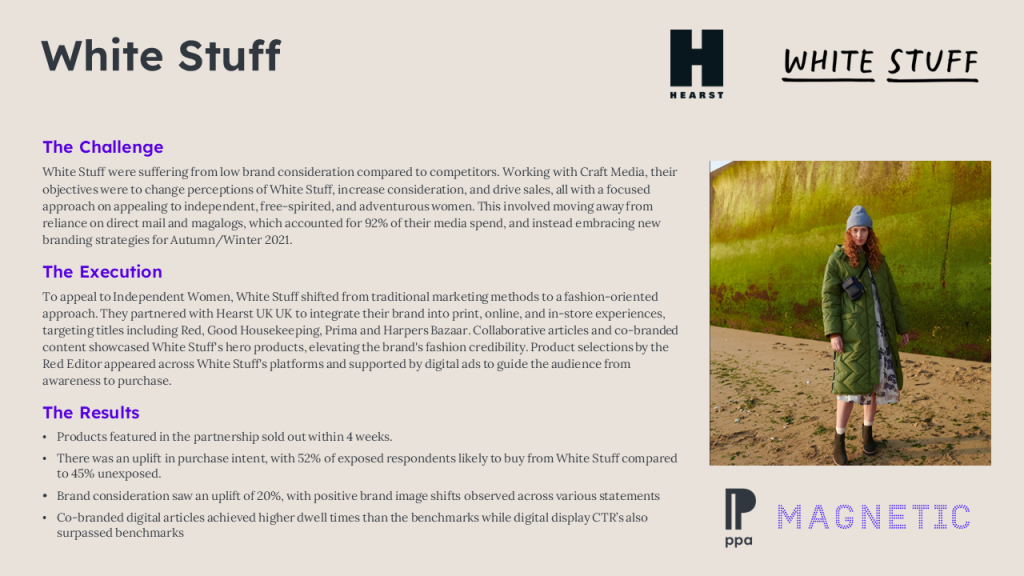Key Takeaways
- White Stuff needed to increase consideration among independent women.
- They partnered with Hearst UK to integrate their brand into print, online, and in-store experiences.
- Products featured in the partnership sold out; purchase intent increased from 45% to 52% and brand image improved.
One page summary

The Challenge
White Stuff, a British fashion and lifestyle brand, faced a challenge of low consideration compared to competitors despite good brand awareness. Their conversion rate from awareness to consideration lagged at 28%, while their closest competitor boasted a 35% conversion rate. White Stuff’s reliance on direct mail and magalogs, accounting for 92% of their media spend, limited their reach to existing customers.
With new branding underway for Autumn/Winter 2021, White Stuff wanted to move away from an older, more traditional shopper and instead attract a new demographic: Independent Women, characterised as independent, free-spirited, and adventurous. Working with Craft Media, their objectives were three-fold – change perceptions of White Stuff, increase consideration of White Stuff and translate into sales – all with a laser focus on Independent Women.
The Plan/Execution
Research identified a defining statement, “To me being beautiful means asserting my personality, my difference,” as the Golden Question distinguishing this demographic. Agreeing with this statement indicated a preference for unique fashion choices over convenience, aligning with White Stuff’s objectives.
To appeal to Independent Women, White Stuff shifted from traditional marketing methods to a fashion-oriented approach. They partnered with Hearst UK to integrate their brand into print, online, and in-store experiences, targeting titles with high readership among Independent Women including Red, Good Housekeeping, Prima and Harpers Bazaar.
In order to shift perceptions, increase consideration and ultimately drive sales, White Stuff needed to lean on the credibility and trust of magazine editors, as the original influencers. Collaborative articles and co-branded content showcased White Stuff’s hero products, elevating the brand’s fashion credibility and helping readers style key pieces from the collection.
Product selections by the Red Editor added endorsement and credibility inside and outside of Hearst UK’s ecosystem. This included White Stuff’s 120 shop windows, swing tags, email newsletters and socials, with the “Red Edits” highlighted on website product pages, a dedicated landing page and in-shop POS. This was supported with digital display and pre
roll video to dial up frequency and move the target audience from awareness, to consideration and purchase.
Results
The integrated approach proved successful in changing perceptions and increasing consideration:
- Products featured in the partnership sold out, with the Sloane coat selling out within four weeks and receiving ten times more views than non-featured coats.
- Post-campaign research using a control vs. exposed methodology showed an uplift in purchase intent, with 52% of exposed respondents likely to buy from White Stuff compared to 45% unexposed.
- Positive brand image shifts were observed, including “White Stuff has moved on its clothing/product ranges” (+7% pts), “White Stuff is a brand for me” (+9% pts), and “White Stuff has clothes/products that I want to buy” (+7% pts), leading to a 20% point uplift in consideration (55% exposed vs. 35% unexposed).
- Co-branded digital articles achieved high dwell times of 2min 9secs and 1min 54 secs on Red and Good Housekeeping respectively, surpassing the benchmark of 1min 30sec.
- In-article digital display achieved CTRs of 1.08% and 0.57% respectively, well above the benchmark of 0.08%.
Digital display and video pre-roll also surpassed benchmarks, with a CTR of 0.17% (vs. 0.10% benchmark) and a video completion rate of 81% (vs. 63% benchmark).


